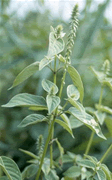
Apamarg

Common Names
About  Taxonomy
Taxonomy
 to access the GRIN database record about the specific taxonomical hierarchy (Family, Genus etc.).
to access the GRIN database record about the specific taxonomical hierarchy (Family, Genus etc.).CLASSIFICATION
ALTERNATE FAMILY
OTHER FAMILY:
SPECIES
Plant Description
Perennial herb (sometimes woody and somewhat suffrutescent), occasionally flowering in the first year, 0.2-2 m, stiffly erect to subscandent or straggling and ±prostrate, simple to much-branched, stems stout to very weak, distinctly to obscurely 4-angled, striate or sulcate, subglabrous to densely tomentose, the nodes ±shrunken when dry. Leaves elliptic, oblong or oval and acute or acuminate to almost round and very obtuse, gradually or abruptly narrowed below, (2-) 3-12 (-16) x 1.3-6 cm, indumentum varying from uniformly subglabrous through subglabrous above and densely appressed-canescent below to ± densely tomentose on both surfaces; petioles of main stem leaves 3-25 mm, shortening above and below. Inflorescences at first dense, finally elongating to (5-) 8-34 (-40) cm; peduncles (0.6-)1-6(-7.5) cm. Bracts lanceolate or narrowly deltoid-lanceolate, pale or brownish-membranous, 1.75-5 (-6) mm, glabrous. Bracteoles 1.5-4.5 (-6) mm, the basal wings 1/3-1/4 (-1/2) the length of the spine and adnate to it, typically tapering off above but not rarely rounded or truncate. Perianth whitish or pale green to red or purple, segments 5, 3-7 (-10) mm, the outer longest, narrowly lanceolate to lanceolate, very acute, with a distinct midrib and 2 obscure to distinct lateral nerves, narrowly or moderately pale-margined. Stamens 5, the filaments 1.5-4.5 (-6) mm, alternating with subquadrate pseudo-staminodes. Typically the apex of the latter curves slightly inwards as a narrow, crenate or entire, often very delicate flap, while from the dorsal surface arises a fimbriate-ciliate scale extending across the width of the pseudo-staminode; not rarely, however, this is reduced to a “stag’s-horn†process at the centre of the dorsal surface, or even becomes small and filiform-or else subapical or apical so that the pseudo-staminode appears simple (this mostly in small forms of var. sicula, which has not yet been found in Pakistan). Style slender, 1-4 (-6) mm. Capsule 1-3 (-5) mm. Seed filling the capsule, cylindrical, smooth.



 Your current navigation map.
Your current navigation map.